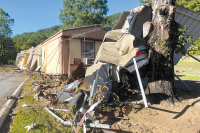The Plott Hound: Bob Plott writes the definitive book on his family’s famed hunting hounds
By Sarah Kucharski • Staff Writer
Owners of Plott Hounds will say that the hound is unlike any other.
“I like to call them multipurpose dogs,” said Bob Plott, great-great-great-grandson of Johannes Plott, the breed’s originator and author of The Story of the Plott Hound: Strike and Stay.
The loyal and tenacious bear dog is inextricably connected with Western North Carolina, its namesake also that of the Plott-Balsam Mountains, Plott Creek and — before it was renamed — Waterrock Knob, which once bore the family name. However, the dog arrived by way of a German immigrant.
Johannes Plott and his brother Enoch were the sons of a gamekeeper to dukes and barons of the Black Forest. Their reason for coming to America remains somewhat unclear. Like so many others they may have simply been in search of a better life. Though after much research Bob Plott has come to speculate that the boys may have been called to the Swiss-German colony at New Bern. The colony was planned such that members had specific purposes to meet the community’s needs. With their training as hunters the Plott boys would have been an important asset, as colony members were unskilled in growing crops in the sandy soils of North Carolina’s coastal lands.
In 1750, Johannes, Enoch and five of their father Elias’ best hounds set sail from Amsterdam for Pennsylvania. Enoch died on the trip and was buried at sea. Upon landing in Pennsylvania, Johannes wasted no time in making his way south to New Bern where he quickly amassed land and raised a family, selectively breeding the dogs and establishing a Plott hound population.
Related Items
It was one of Johannes sons, Henry, who headed west arriving in Haywood County in 1799 or 1800. Johannes died in 1810 and bequeathed to his son the family hounds, which had begun to earn a reputation for their versatility as a hunting and herding dog that was docile yet protective of its family.
As the Plott family grew, so did the Plott hound’s status, and people from increasingly far away would come to Plott Valley in search of the famous bear dogs. By the turn of the century, Horace Kephart documented the Plott Hound in Our Southern Highlanders.
“Have these dogs got the Plott strain? I’ve been told that the Plott hounds are the best bear dogs in the country,” Kephart wrote of asking a fellow about bear hunting and his dogs.
The breed finally was officially recognized around 1946 when hunters in the American West began pushing to have the Plott registered by the United Kennel Club. Of UKC’s six registered coonhound breeds, the Plott hound is the only one not to trace its ancestry back to the foxhound. The National Plott Hound Association was formed in 1965. And the Plott Hound was one of four new breeds to be recognized at the Westminster Kennel Club Dog Show this year.
Bob Plott, a resident of Statesville, has spent most of his career in manufacturing management and martial arts instruction. He was encouraged to investigate his family’s history and their great dogs by the birth of his own son.
“I kind of feel a family obligation if you will,” Plott said.
While out hiking with good friend George Ellison, Plott mulled over the idea of a book. Ellison, who among other things wrote the biographical introduction for the reissue of Kephart’s Our Southern Highlanders, agreed to be Plott’s unofficial editor and helped Plott secure a contract with The History Press to publish The Story of the Plott Hound: Strike and Stay.
“And so I wrote the book,” Plott says with a laugh.
Ellison’s wife, Bryson City watercolorist and gallery owner Elizabeth Ellison, illustrated the book’s cover with the image of a sturdy dark brindle Plott Hound, the breed standard.
Today, Plott has his own two hounds, Crockett’s Archie, 3, and Plott’s Bud, 11 months. It’s his first serious foray into breeding.
“I feel an obligation to try to perpetuate the two strains that are the most representative of the old time dogs,” Plott said.









